August 16th, 2021 · Comments Off on Principles of Cerebral Mechanics
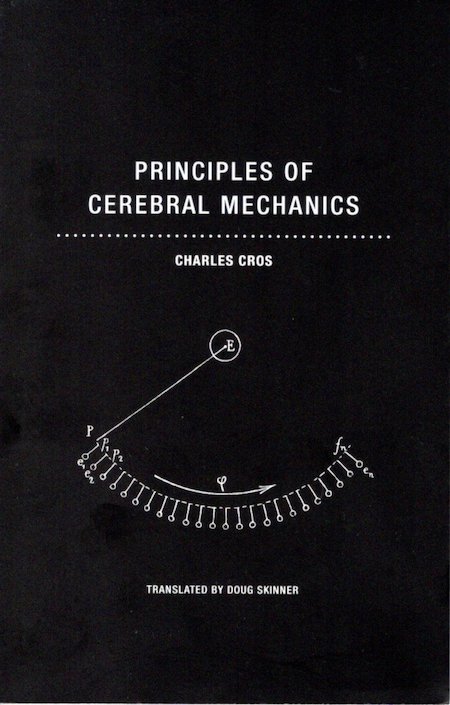
Principles of Cerebral Mechanics is now available from Wakefield Press! This is my third translation of Charles Cros (these are the others). Here’s how Wakefield describes it:
Though lesser known among the scientific writings of Charles Cros, Principles of Cerebral Mechanics is a visionary work that further establishes the author’s standing as the inventeur maudit of his time. First presented to the Academy of Sciences in 1872, it wasn’t published until 1879, and then only in fragmentary form before the journal in which it appeared folded, and what Cros claimed to be the only manuscript copy had been thrown into a fire by his mistress during a lover’s quarrel.
Setting out to understand the mechanics of perception, the organs of which were too small and inaccessible to be studied directly at the time, Cros attempted to reverse engineer the sensory apparatus. Whereas his inventions in the realms of audio recording and color photography focused on technology for the senses, with this ambitious essay Cros turned to conceptualizing the technology of the senses themselves: rather than the transmission of color to the retina, here he tried to conceive of how color was transmitted from the retina to the brain. By approaching the human brain as a “mechanism of registration” and conceptually dissecting it into the gears of an image recorder, Cros’s essay can be set alongside the groundbreaking work of such revolutionary figures who transformed modern vision as Étienne-Jules Marey and Eadweard Muybridge.
Charles Cros (1842–1888) was as much Renaissance man as he was poète maudit. A bohemian poet who drank with Verlaine and at one point provided housing to Rimbaud, he also developed the comic monologue as a theatrical genre, and invented both the phonograph (which he named the “paléophone”) and color photography (though he failed to patent either before Thomas Edison or Louis Ducos du Hauron), among other such inventions as a non-metallic battery and a musical stenographer. “The freshness of his intelligence was such that no object of desire seemed utopian to him a priori,” André Breton wrote of him, adding: “The pure playfulness of certain wholly whimsical portions of Cros’s work should not obscure the fact that at the center of some of his most beautiful poems a revolver is leveled straight at us.”
Tags: *Words · P
August 9th, 2021 · Comments Off on Typos on Title Pages
For the “Errata” edition of the Black Scat Review, I came up with a list of unfortunate typos on title pages. I particularly enjoyed inventing fictional publishers. Here’s how it begins:
TYPOS ON TITLE PAGES
H. L. Mencken once observed that a book is most likely to have a typo on the title page, since many publishers forget to proof it. Most of these typos, naturally, are innocuous. The reader who opens The Tempest and finds The Tempesr generally ignores it and reads on. When a typo results in a different word, however, it also creates a new, and often inappropriate, title. The editions listed below, culled from booksellers’ catalogues, now command surprisingly high prices from collectors.
20,000 LEAGUES UNDER THE SEAT: This mass-market paperback, published by Deuce Books in 1959, was part of a series of Jules Verne’s novels marketed to children. The last word suggested a scatological interpretation, to the delight of its intended audience.
THE GOSPEL ACCORDING TO JOHNS: Careless typesetting marred this otherwise handsome letterpress chapbook of the fourth Gospel, published by the Swansworth Press in 1931. The Holy Bible did depict Jesus and His apostles consorting with prostitutes, but not as customers.
THE DONG OF SOLOMON: Swansworth was also responsible for this 1933 edition, whose title seems to trivialize the immortal love song of the Old Testament. It also tempts the reader to scrutinize Hypatia Wigmore’s illustrations differently than she intended.
THE SOUND AND THE FURRY: William Faulkner’s novel was afflicted with this puzzling typo in a 1952 edition from Windcastle Books. The meaning is elusive, but the images it summons are vaguely sexual, and have little to do with either the plot or themes of the book.
…
Tags: *Words · T
August 1st, 2021 · Comments Off on Maybe Those Hornets Would Like These Posies
One of my musical preoccupations in July was a set of eleven duets for tenor recorder and viola (or other suitable instruments). Each is 33 measures long; here’s the first one.
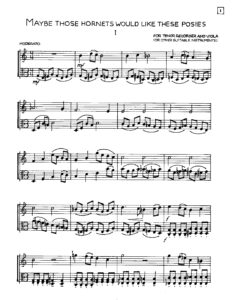
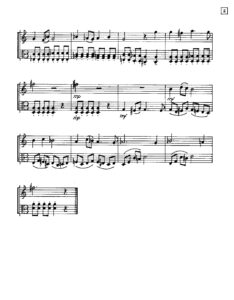
Tags: *Music · M
July 25th, 2021 · Comments Off on Ada and Gabe
This story recounts the romance between Princess Ada and her suitor, Prince Gabe. She’s rather GAGA, and he, frankly, is A BEEF-FACED FEEB. But music is the food of love!
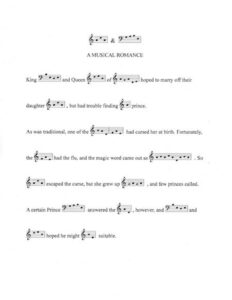
Tags: *Music · *Words · A
July 21st, 2021 · Comments Off on Twinge
Some piano music, all in the upper register.
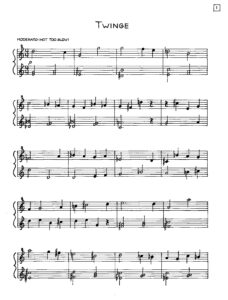
Tags: *Music · T
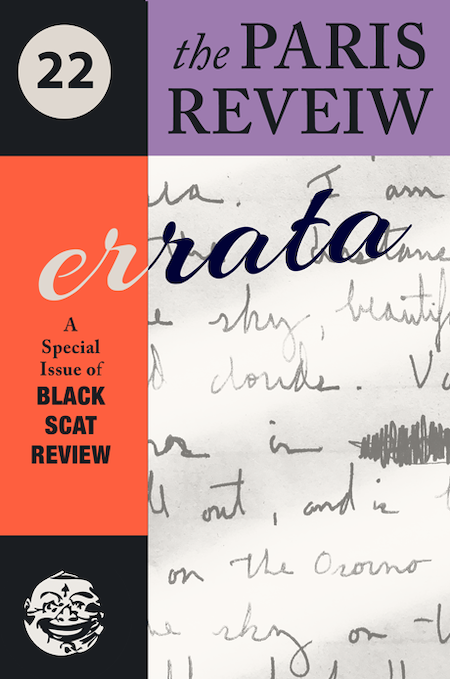
The 22nd issue of Black Scat Review is now available! This is the “Errata” issue, and contains my contributions “Shakespeare Misspelled” and “Typos on Title Pages.” It also features texts, comics, collages, and drawings by my lively colleagues Terri Carrion, Norman Conquest, Caroline Crépiat, Farewell Debut, S. C. Delaney, Jean-Pierre Duffour, Errorbiblioteca, Paul Forristal, Ryan Forsythe, Eckhard Gerdes, Rhys Hughes, Amy Kurman, Alex McKeown, Claudio Parentela, Angelo Pastormerlo, Agnès Potier, Collin J. Rae, C. R. Resetarits, Jason E. Rolfe, Paul Rosheim, Kristine Snodgrass, Linda Klieger Stillman, Corinne Taunay, Michel Vachey, and Carla M. Wilson, and is edited and designed by Norman Conquest. It’s available on Amazon from Black Scat Books. More mistakes for your money!
Tags: *Words · B
July 14th, 2021 · Comments Off on Duet for Slide Whistle and Trombone
The slide whistle and the trombone seem made for each other. This duet shows off both of them, in four movements of 33 measures each.
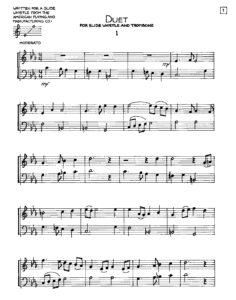
Tags: *Music · D
July 5th, 2021 · Comments Off on Duet for Garklein Recorder and Tuba
This spirited duet pairs the garklein recorder, the smallest member of the recorder family, with the tuba. The two contrasting sonorities are combined in unison, in harmony, in antiphony, and in canon, mostly in C major, before ending their tenuous alliance.
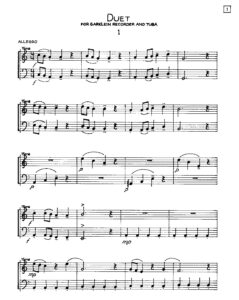
Tags: *Music · D
June 30th, 2021 · Comments Off on Le Chat Noir Exposed

Le Chat Noir Exposed is now available from Black Scat Books!
This extraordinary work of scholarship exposes the liveliest fin-de-siècle bohemian cabaret and paper in Paris. Le Chat Noir was a playground for painters, writers, poets, pranksters, and musicians, all gleefully demolishing the standards of art and good taste. Caroline Crépiat examines such eccentric personalities as Paul Verlaine, Alphonse Allais, Marie Krysinska, Maurice Mac-Nab, and Charles Cros, and analyzes their treatment of money, women, translation, humor, sex, disease, and scatology, with generous samplings of the original texts. A masterful look at a rich and colorful legend of the avant-garde! Translated by Doug Skinner and available from Black Scat Books!
Tags: *Words · C
June 22nd, 2021 · Comments Off on The Secret Sentence
In this univocalic story from The Snowman Three Doors Down, Ebenezer and Celeste have to decipher a coded message sent by the settlers. This may mean trouble for Fessenden. Here’s how it begins…
THE SECRET SENTENCE
Ebenezer’s beeper beeped.
He pressed the desk beeper; Celeste entered the belvedere.“Yes?” she beseeched.
He greeted her, petted the settee. She tested the red felt, settled her belted velveteen dress there, shed her checkered beret.
Ebenezer held three deckle-edged sheets. “The settlers sent these,” he wheezed.
Celeste clenched her teeth. “The repellent settlers,” she seethed. “The helpless bedwetters. The dregs.”
The Bethlehem Brethren nestled the settlement, Western Eden, between deserted fern-bedecked glens. There, the settlers kept bees, herded sheep, tended the cress beds, fed the geese, erected fences, swept the temple, mended the evergreen hedges. The men elected the eldest, Fessenden, exec: he refereed melees between the shepherds, prevented the beekeepers’ keenest excesses, stemmed the revelers’ fevered keggers. He sent the Brethren the settlement’s emblements, kept the ledgers.
“Well, the extreme elements depress them,” fretted Ebenezer. “The sleet’s severe. Endless tempests drench the greenbelt, swell the creeks. Relentless December breezes freeze the cheerless cement cells. The feed’s never fresh: the eggs smell, the cheese reeks, ferrets deplete the green peppers, beetle feces wreck the fennel seeds. The wet spelt kernels ferment. The men get restless, then reckless. Yet Fessenden’s decent.”
“Fessenden’s dense,” she jeered. “Hell, he’s the densest dweeb there.”
“He never pretended he’s clever. Nevertheless, he’s been excellent,” Ebenezer defended. “The genteel bellwether, the fervent trendsetter, the level presence. He deserves respect; he’s served the Brethren well.” …
Tags: *Words · S









